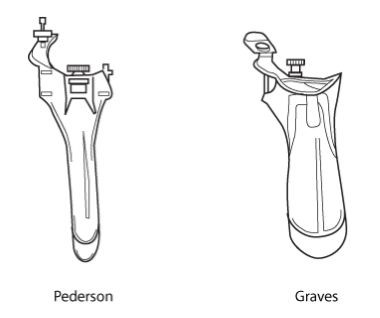Speculum Exam and Papanicolaou (PAP) Smear
- Appropriate style/size of speculum (see discussion below)
- Light source
- Warm water or water-soluble lubricant
- Non-sterile gloves
- Cytobrush and spatula
- Fixative spray
- Glass slide labeled with 2 client identifiers: client name, date of birth and/or health services number
- Glass slide case
- PAP requisition
- History checklist, reason for the Pap smear, any abnormalities noted (e.g., herpes, vaginal infection), the sampling tools used and LMP, pregnancy, date of menopause, and current contraceptive use.
- You may wish to have culture swabs for BV/Candida available in case of client complaints of discharge or odour, or in the event that you note unusual findings on exam.
Speculums
It is essential that you become thoroughly familiar with how the speculum operates before you begin the examination. In your review, be sure to include the disposable plastic speculum (see figure below), since the mechanism action of this type of speculum is somewhat different. Plastic specula typically make a loud “click” when locked or released; therefore, please forewarn your patient about this click to avoid surprise and unnecessary anxiety.

The speculum consists essentially of two blades and a handle. Two views are shown below, and a discussion of individual parts follows.
Examine the blades first.
- The upper and the lower blade can each be divided into three parts: a base, a body and a tip.
- The two blade bases together may be called the base of the speculum.
- The speculum base is flared and forms a viewing aperture.
Next, look at the three pieces added to, or extending from, the bases of the blades.
- The first–a lever extending from the base of the upper blade–may be called the speculum lever (or notched locking tab or thumbplate). The angular opening adjustment holds the speculum open when the notched locking tab is pressed down.
- The others–a Y-shaped piece attached to the base of the upper blade, and an L-shaped piece extending from the base of the lower one–together make up the speculum handle.
- The vertical opening adjustment is used to extend the viewing aperture. It can be slid down to open the aperture wider. This is a useful technique when vaginal walls are flaccid and fall into themselves.
Some sites utilize a metal speculum. These have a rod inserted through the lever and attached to the handle. The rod is threaded and carries a nut, and the two pieces may be called the lever rod and lever nut (or adjustment screw), respectively. Finally, note the bolt similarly inserted through the two components of the handle and also carrying a nut–these two pieces may be called the handle bolt and handle nut, respectively. These are demonstrated in the depiction of the Graves and Pederson specula below.


After the health history, you will have an idea of the appropriate type and size of speculum needed. There are two basic types: the Graves specula, and the Pederson speculum (see figures above).
The Graves speculum is most commonly used for the adult female client. It varies in length from 9-13 cm and is 4 cm wide. Most of the disposable specula that are available are Graves specula and come in small, medium and large sizes. The Pederson speculum is both narrower and flatter than the Graves speculum, and it is used with virgins, nulliparous patients, circumcised patients, or patients whose vaginal orifices have contracted postmenopausal. They will need to be special ordered.

The Pap is best performed when the patient has had:
- no heavy menstrual bleeding (i.e., mid-cycle; day 10-20 sampling is ideal)
- nothing in the vagina for at least 24 hours; this includes: no intercourse, douching, vaginal medications, or contraception (except for the NuvaRing; Hatcher et al., 2004)
